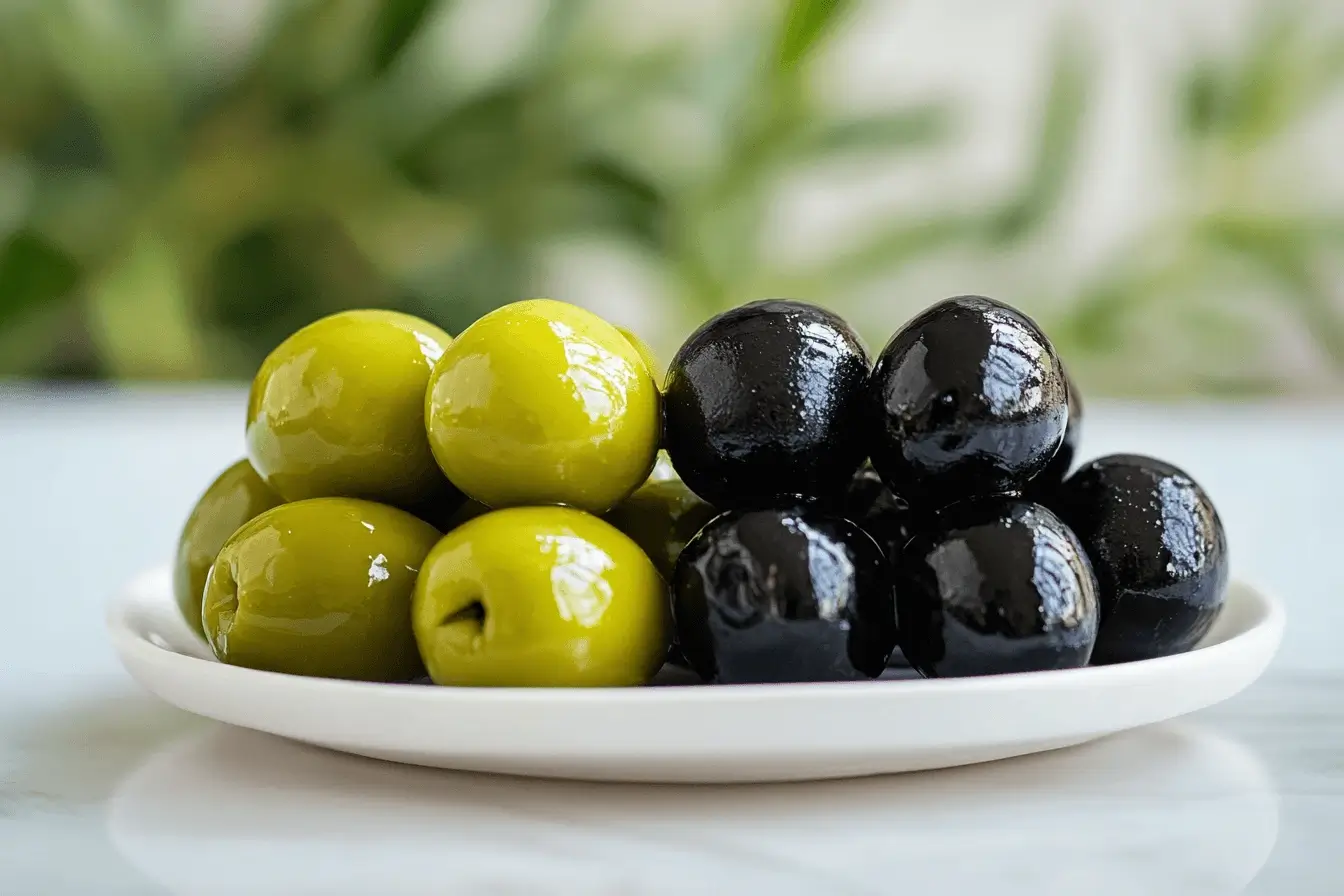Which olives are healthier green or black? Discover the Truth
Olives have played a key role in Mediterranean diets for centuries, valued for both their rich flavor and incredible health benefits. Yet, a common question remains: Which olives are healthier, green or black? Although both green and black olives offer a wide range of nutritional benefits, they differ in composition, taste, and potential health effects.
In this article, we’ll explore whether green or black olives are the better option. By comparing their nutritional profiles, health benefits, and culinary uses, you’ll be better equipped to make the healthiest choice for your diet and lifestyle.
The History and Cultural Importance of Green or Black Olives
Before diving into the nutritional details, it’s essential to understand the historical and cultural value of olives. Over 6,000 years ago, olives were cultivated in the Mediterranean region. Ancient civilizations like the Greeks, Egyptians, and Romans revered olive oil, even referring to it as “liquid gold.”
The olive tree’s significance runs deep, symbolizing peace and prosperity in various traditions. For instance, the olive branch served as a symbol of victory in ancient Greece, and it continues to symbolize peace today. Additionally, the Bible, Quran, and Torah reference the olive tree as a divine gift, further emphasizing its sacred status across many cultures.
The longevity of olive trees is impressive. Some trees live over 1,000 years, producing fruit throughout their lifespan. These facts make olives more than just a staple food; they stand as symbols of endurance, wisdom, and vitality.
This rich history elevates olives beyond mere health food, making them a cultural icon embedded in tradition, peace, and resilience.
What Makes an Olive Green or Black?
Green vs. Black Olives: Ripeness and Processing
The question often arises, which olives are healthier, green or black? The answer depends largely on the stage of ripeness at which they are harvested. Green olives are picked before they fully ripen, while black olives remain on the tree to mature completely. This difference in ripeness not only affects the olives’ color but also their flavor, texture, and nutritional content. By understanding the distinctions between the two, you can make a more informed choice when deciding which olives to include in your diet.
The Role of Curing in the Health of Green or Black Olives
After harvesting, olives undergo a curing process to remove their natural bitterness. This curing—whether through brining, salting, or oil curing—affects their sodium content and flavor. Green olives, which tend to have a stronger, more bitter taste, contrast with black olives, which are milder and softer. The curing method also impacts the nutritional properties of both, influencing their respective health benefits. Curing methods like brining may significantly raise sodium content, as seen in certain traditional Mediterranean dishes, such as this easy creamy chicken potato soup, where olives may be used to add flavor and texture.

Curing methods can also influence the sodium levels found in olives. For example, brining involves soaking olives in a saltwater solution, which leads to higher sodium content. On the other hand, curing with dry salt or oil tends to result in lower sodium levels. These differences become essential when choosing olives based on dietary needs, particularly for those managing cardiovascular conditions like hypertension.
Additionally, the nutritional properties of green and black olives depend on their variety and the region where they grow. For instance, olives from Spain or Italy may exhibit distinct flavor profiles and varying levels of nutrients, thanks to the unique climate and soil conditions in those regions.
Are Green and Black Olives from Different Trees?
Many people mistakenly believe that green and black olives come from different trees. However, both types come from the same olive tree. The difference lies in their harvest time: green olives are picked when unripe, while black olives are left to fully mature. Nonetheless, olive varieties and processing methods account for differences in taste, texture, and nutritional value.
Hundreds of olive varieties exist, each offering unique characteristics. For instance, some trees are cultivated specifically for their oil, while others are grown for table olives. The variety and timing of the harvest determine whether the olive will be green or black.
Moreover, certain regions are renowned for producing particular olive varieties. For instance, Kalamata olives from Greece are famous for their rich, fruity flavor, while Castelvetrano olives from Sicily boast a mild, buttery taste. Although these olives can be harvested at various stages of ripeness, their foundational growth process remains the same.
Green or Black Olives in Traditional Medicine
Throughout history, both olives and olive oil have been used in traditional medicine. For example, ancient civilizations applied olive oil to heal wounds, soothe digestion, and reduce inflammation. Today, research backs many of these ancient uses, showing that the polyphenols and healthy fats in olives help reduce inflammation and improve overall health.
Olive oil has also long been considered beneficial for heart health. In ancient Greece and Rome, olive oil was viewed as a sacred substance that protected the skin, anointed the body, and promoted longevity. Today, the Mediterranean diet, which is rich in olive oil, is associated with a lower risk of heart disease, cancer, and even Alzheimer’s disease.
Additionally, olives have been widely used in skincare for their moisturizing properties. Olive-based products are believed to enhance skin elasticity and reduce the signs of aging. The vitamin E content in olive oil helps combat free radicals, which cause skin damage, making olive oil a natural remedy for aging skin.
Furthermore, olive leaves have been utilized for centuries in traditional remedies. Olive leaf extracts, known for their antiviral and antimicrobial properties, continue to be used as herbal treatments for infections and immune support.
Different Varieties of Green or Black Olives
Popular Green Olive Varieties
Several varieties of green olives offer distinct flavors and uses. For instance, Manzanilla, commonly used in snacks, can be a great addition to appetizers. Similarly, Picholine is a French variety often paired with cheese in classic Mediterranean pairings, like those found in green olive-based dinner recipes.
- Manzanilla: A small, firm olive commonly used in cocktails or eaten as a snack. Often, this variety is stuffed with pimentos or garlic for extra flavor.
- Picholine: A French variety with a crisp bite, often paired with cheese. Its firm texture makes it ideal for appetizers and canapés.
- Castelvetrano: Known for its mild, buttery flavor, Castelvetrano olives are perfect for salads. These olives are popular in gourmet dishes due to their unique taste and versatility.
- Cerignola: Large and mild in flavor, Cerignola olives work well for snacking or in antipasto platters. Often served whole, they are a staple of Mediterranean cuisine.
Well-known Black Olive Varieties
Similarly, black olives come in various types, each with its own characteristics:
- Kalamata: A large, dark olive with a fruity flavor, commonly found in Greek salads. Kalamata olives are famous for their rich, robust taste, making them a staple in Mediterranean dishes.
- Gaeta: Slightly sweet, Gaeta olives are ideal for antipasto platters. These olives are typically cured in brine and served as part of Italian antipasti.
- Niçoise: Small and salty, Niçoise olives frequently garnish salads and appear in French dishes, particularly in Niçoise salads.
- Mission: Common in the U.S., Mission olives have a mild flavor, making them perfect for pizzas, salads, and other American dishes.
Nutritional Comparison of Green or Black Olives
Nutritional Breakdown: Calories, Fats, and Sodium
When evaluating which olives are healthier, one key factor to consider is their nutritional breakdown. For example, black olives tend to have lower sodium levels compared to green olives. You may find that this nutritional distinction influences your choice in making heart-healthy meals, such as soups or stews that balance sodium intake, like this article on boiling potatoes in chicken broth.


Here’s a breakdown of green and black olives per 100g:
| Nutrient | Green Olives | Black Olives |
|---|---|---|
| Calories | 145 kcal | 115 kcal |
| Total Fat | 15g | 10g |
| Saturated Fat | 2.0g | 1.5g |
| Monounsaturated Fat | 11g | 7.5g |
| Sodium | 1550mg | 735mg |
| Fiber | 3.8g | 2.6g |
Green or Black Olives: Which Is Healthier for Calories and Fat?
Olives have played a key role in Mediterranean diets for centuries, valued for both their rich flavor and incredible health benefits. Yet, a common question remains: Which olives are healthier, green or black? Although both green and black olives offer a wide range of nutritional benefits, they differ in composition, taste, and potential health effects.
In this article, we’ll explore whether green or black olives are the better option. By comparing their nutritional profiles, health benefits, and culinary uses, you’ll be better equipped to make the healthiest choice for your diet and lifestyle.
It’s important to mention that both types of olives are rich in monounsaturated fats. These fats have been shown to lower LDL (bad) cholesterol and raise HDL (good) cholesterol, making olives a heart-healthy addition to your diet, regardless of their color.
Sodium Content: Why Green Olives Are Saltier
Green olives contain significantly more sodium due to the curing process. Thus, black olives often become a better choice for those monitoring their salt intake. High sodium levels can contribute to high blood pressure, so black olives may be the healthier option for cardiovascular health.
However, there are ways to reduce sodium content in green olives. Soaking them in water before eating can help remove some of the salt, making them a more heart-friendly choice for those watching their sodium levels.
Health Benefits of Green or Black Olives
Antioxidants: The Strength of Green Olives
One of the key factors in determining which olives are healthier, green or black is their health benefits. Green olives are particularly rich in antioxidants such as polyphenols and flavonoids, making them excellent for fighting inflammation and reducing the risk of chronic diseases. On the other hand, black olives, while containing slightly less fat, provide significant heart health benefits due to their high content of monounsaturated fats.

Polyphenols, especially, play a key role in preventing oxidative stress, which is linked to conditions such as heart disease and cancer. By incorporating green olives into your diet, you actively work to neutralize free radicals and protect your cells from damage.
Heart Health: Black Olives for Cardiovascular Support
While black olives contain more fat, most of it is heart-healthy monounsaturated fat. This type of fat helps lower bad cholesterol (LDL) while raising good cholesterol (HDL). Including black olives in dishes such as Mediterranean salads or snacks like fresh, tangy lemon cucumber recipes is a simple way to boost cardiovascular health while adding flavor to your meals.
Additionally, the monounsaturated fats in black olives may reduce arterial inflammation, further supporting heart health. Including black olives in your diet is particularly beneficial for maintaining healthy cholesterol levels.
Eye Health: Vitamin A in Green Olives
Green olives are an excellent source of vitamin A, which is essential for maintaining healthy vision. A diet rich in vitamin A helps protect against age-related eye conditions such as cataracts and macular degeneration.
Furthermore, vitamin A supports the proper function of the retina, which is crucial for vision, especially in low-light conditions. By adding green olives to your meals, you help ensure that you’re getting enough vitamin A to promote good eye health.
Bone Health and Inflammation Control
Both green and black olives are rich in calcium, supporting strong bones. Additionally, the polyphenols in olives help reduce inflammation, which can be beneficial for those with conditions like arthritis. For a more anti-inflammatory diet, incorporating olives in recipes like easy creamy chicken potato soup could further enhance their benefits.
Recent studies also suggest that olives’ anti-inflammatory properties may help prevent bone loss, making them an excellent addition to the diet for individuals at risk of osteoporosis.
How Green or Black Olives Support Gut Health
Fermented olives contain beneficial probiotics that support digestive health. Furthermore, the fiber in olives aids regular bowel movements and promotes a healthy gut. Including olives in your diet can improve digestion and overall gut health.
Probiotics found in fermented olives introduce healthy bacteria into the digestive system, helping to balance the gut microbiome. A well-balanced microbiome is linked to several health benefits, including improved immunity, better mental health, and reduced inflammation.
Choosing the Best Green or Black Olive Products
When shopping for olives, look for these features:
- Organic certification to ensure no exposure to harmful pesticides.
- Extra virgin olive oil to maximize the nutrients and antioxidants in your olive products.
- Low-sodium options for those who need to limit salt intake.
Additionally, pay attention to the packaging. Opt for olives stored in glass jars or BPA-free cans to avoid exposure to harmful chemicals in packaging materials. This is especially important for olive oil, as improper storage can lead to oxidation and a loss of nutrients.
Olive Oil: Green and Black Olives’ Best Output
Extra Virgin Olive Oil: A Health Superfood
Extra virgin olive oil ranks among the healthiest oils due to its high monounsaturated fat content. Regular consumption of extra virgin olive oil has been linked to reduced inflammation, improved cholesterol levels, and overall better heart health.
Moreover, extra virgin olive oil contains more polyphenols than other types of olive oil. These antioxidants protect the body from oxidative damage and inflammation, further enhancing its status as a heart-healthy superfood.
Cold-Pressed vs. Refined Olive Oils
Cold-pressed olive oil retains more nutrients since it’s produced without heat. Refined olive oils, on the other hand, lose many beneficial compounds during processing. Choosing cold-pressed olive oil ensures you’ll get the maximum health benefits.
Cold-pressed oils also tend to have richer flavors and are less processed than refined varieties, making them a healthier and more flavorful option for cooking or dressing salads.
Culinary Uses and Flavor Profile of Green or Black Olives
How to Use Green and Black Olives in Your Meals
Green and black olives enhance many dishes, ranging from appetizers to main courses. While green olives, with their bold flavor, work well in tapenades, black olives lend a more subtle taste to pizzas, salads, and pastas.
Additionally, green olives pair beautifully with ingredients like almonds or feta, adding both flavor and nutritional value. Similarly, black olives are staples in Mediterranean cuisine, often used to complement dishes like Greek salads and pasta.
Cooking Recipes with Green or Black Olives
Green Olive Tapenade Recipe
- 1 cup green olives, pitted
- 1 clove garlic
- 1 tbsp capers
- 2 tbsp olive oil
- 1 tsp lemon juice
Combine all ingredients in a food processor, blend until smooth, and serve with crackers or bread.
Black Olive Pesto Recipe
- 1 cup black olives, pitted
- 2 cloves garlic
- 1/4 cup fresh basil
- 2 tbsp pine nuts
- 1/4 cup olive oil
Blend all ingredients and use as a pasta sauce or spread on toast.
Environmental Impact of Green and Black Olive Farming
Sustainability of Olive Farming
Olive farming can impact the environment through deforestation and excessive water use. However, many farmers are adopting sustainable farming methods to reduce their environmental footprint.
In regions such as Spain and Italy, more farmers are turning to organic practices, which reduce pesticide use and promote biodiversity. Additionally, some olive producers are implementing rain-fed irrigation systems to minimize water usage and promote sustainable agriculture.
Choosing Sustainable Olive Products
By choosing organic and sustainably farmed olives, you can reduce your environmental impact. Organic olives are grown without harmful pesticides, supporting both your health and the environment.
Look for certifications like “Fair Trade” and “Rainforest Alliance” to ensure that olive products come from ethical and eco-friendly practices. These certifications also guarantee that farmers receive fair wages and work in safe conditions.
Which Olive Should You Choose: Green or Black?
Tailoring Your Choice Based on Health Needs
- If you need to reduce sodium, black olives are a better option.
- If you want more antioxidants, green olives are your best choice.
- If heart health is your priority, black olives provide heart-friendly fats.
When deciding which olives are healthier, green or black, it’s essential to consider your health goals. If you’re trying to reduce your sodium intake, black olives may be the better option. Conversely, if you’re looking for an olive that provides a rich source of antioxidants, green olives might be the healthier choice. Ultimately, the best option depends on your personal health needs and taste preferences.
Conclusion: Green or Black Olives, the Final Verdict
So, which olives are healthier, green or black? Both varieties offer distinct advantages depending on your dietary needs. Green olives provide a higher concentration of antioxidants, while black olives are lower in sodium and offer heart-healthy fats. Whether you prefer the bold flavor of green olives or the milder taste of black olives, both types can be incorporated into a balanced, health-conscious diet.







